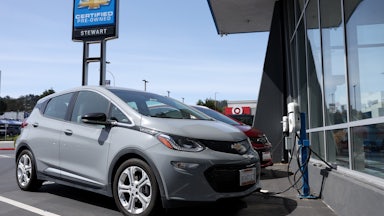On Tuesday, electric car maker Rivian announced it will adopt Tesla’s North American Charge Standard, or NACS. The move follows similar announcements from Ford and GM in recent weeks; Hyundai is reportedly mulling a shift too. Allowing non-Teslas into the extensive Tesla charging network will be a boon for the company: The flurry of new deals could add some $3 billion to Tesla’s revenue in 2030 and more than $5.2 billion in 2032. It could also give one company and its mercurial, right-wing CEO enormous sway over how and where infrastructure critical to decarbonization gets built.
As Jeff St. John noted at Canary Media, the switch won’t be so quick. Ford and GM won’t start making NACS-compatible cars until 2025, and Tesla’s existing charging network won’t be able to accommodate Fords, GMs, and other cars overnight. Chris Nelder, host of the Energy Transitions Show podcast and a former E.V. analyst, told me that this sudden shift toward NACS could cause “significant delays,” both in the deployment of E.V. chargers and customers’ willingness to make the switch to electric. Non-Tesla charging companies will need to retrofit their existing fleet to accommodate the 60 to 70 percent chunk of the E.V. market now on track to use the Tesla chargers, while prospective car buyers might also opt to wait until they can buy a car that will match the network, keeping internal combustion vehicles on the road for longer. That could slow progress to get U.S. drivers to adopt E.V.s—which still make up just 1 percent of cars on the road—even more.
That the switch is happening at all is at least in part the product of public policy. Last year, the Bipartisan Infrastructure Law allocated $7.5 billion to eventually build 500,000 electric charging stations. Attached to those funds are a few strings. The U.S. Department of Transportation’s Federal Highway Administration last June announced new standards for any company applying to use federal funds. In addition to locating new chargers near highways, charging manufacturers will need to make their charging stations accessible to all vehicles. Following the introduction of these standards, Tesla changed its policy so as to be eligible for the new funding, opening up its charging network to non-Tesla drivers. The company slapped a bold, official-sounding name on its new plugs. The North American Charging Standard is good branding, but not technically a standard.
Nor is it entirely open. As St. John writes, “Any companies seeking to make their EVs compatible with Tesla’s NACS will need permission from Tesla to access its charging network itself, as well as to write the software to integrate with its proprietary charging interface and billing systems.” In order to get federal funds, Tesla will also need to provide chargers for the Combined Charging System model, or CCS—the current model of charging that many once thought would become the norm.
This all bodes poorly for other companies looking to make money off a U.S. charging network. What was already an uphill battle for third-party E.V. charging companies could now become a losing one.
At least for now, building charging stations is a punishing business. Just two public chargers can cost upward of $1 million, Nelder told me. After getting the green light from local planning authorities that decide where charging stations can be built and more granular details like how wide parking spaces can be, companies have to lay cables and—in many cases—negotiate over demand charges with electric utilities. Whereas gas stations are often owned by oil companies, electric charging stations distribute electricity generated elsewhere by utilities. The rates those utilities charge customers are regulated by statewide public utility commissions, which have adopted a wide range of rules for how to treat E.V.s. Those rates reflect how regulators and utilities categorize charging stations, and many states lump them in with manufacturers.
Bloomberg’s Liam Denning notes that EVgo, Chargepoint Holdings Co., and Blink Charging Charging Co., leaders in the charging industry, have a combined market capitalization of $5 billion, with just $550 million in total cash on hand. Experts estimate that they would need to reach 30 percent utilization rates, though even top-performing charging stalls don’t tend to hit that number currently.
“Those guys are now double screwed,” Nelder says of third-party charging companies. “If all these automakers are going toward the NACS standard, they need to go retrofit their chargers with this new connector or encourage the availability of adapters. It’s going to be a wonky, expensive mess for them, and they were already struggling to come up with enough cash.”
Several states have either implemented or are considering “time of use” rates, adjusting costs for charging based on times when more and less people are using the grid—an adjustment that is ultimately paid by the owners of the charging stations. Those firms then decide whether to pass those costs along to consumers directly or figure out a more standardized rate that accounts for fluctuations, ensuring customers who charge during peak demand periods aren’t made to pay more for a charge than they would have a few hours earlier. Prices at the plug also include overhead for charging stations owners, from maintenance to payment systems and construction costs.
Then there’s all the little stuff. California—which has some of the country’s most supportive rules for E.V. adoption—was home to an intense battle a few years back over whether chargers would be mandated to include credit card swipers, as opposed to just contactless payment. Unlike gas stations, customers can also fuel up at home. Given that nearly half of all car trips are three miles or less, drivers who primarily make short trips could opt to avoid charging stations entirely.
The expense and administrative hurdles to building E.V.s would seem to make it easier for bigger and more diversified companies to butt into the space, especially those that can afford to subsidize their charging business with funds from other revenue streams. Drivers might also prefer not to have to fumble around with a handful of different apps and company-specific cards whenever they want to charge up. With 17,000 chargers, Tesla’s network is much bigger than any of the other networks, which have around 7,500 total, Nelder told me. “It’s also much faster, and well maintained,” he said. “The third-party charging networks are a balkanized mess, and they have an extremely challenging business. If Tesla had to live and die on its charging business on its own, they wouldn’t have made it either.”
The potential for a single private company to dominate the country’s public charging network, however, could understandably perk up the ears of antitrust regulators—or anyone who’s watched Musk’s recent antics with concern.










